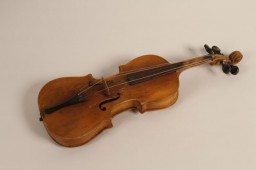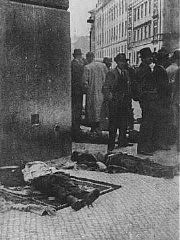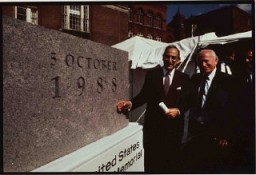You searched for: hiding
<< Previous | Displaying results 271-280 of 499 for "hiding" | Next >>
-
Westerbork
ArticleThe Westerbork transit camp, located in the German-occupied Netherlands, served as a temporary collection point for Jews in the Netherlands before deportation.

-
Boruch Golden's violin
ArtifactA childsize violin that belonged to Boruch Golden (Gordon), who was killed along with his mother and brother at the Ponary killing site in September 1943. Boruch was born in 1930, and was one of four children. His parents, Moshe and Basia Golden (Gordon), raised their family in Swieciany (Svencionys), Lithuania. After the German invasion of the Soviet Union in June 1941, the family was forced into the Swieciany ghetto. When that ghetto was later liquidated in 1943, the family was sent to the Vilna…

-
D-Day bombings over France
FilmAllied air superiority over Germany was a decisive factor in the success of the D-Day (June 6, 1944) landings in France. This footage shows the Allied bombing of suspected German positions during the battle. Allied air attacks both supported Allied ground operations in Normandy and prevented German reinforcements from reaching the area. The Allies would liberate most of France by the end of August 1944.

-
Liberation of major Nazi camps, 1944-1945
MapAs Allied troops moved across Europe in a series of offensives on Germany, they began to encounter and liberate concentration camp prisoners, many of whom had survived death marches into the interior of Germany. Soviet forces were the first to approach a major Nazi camp, reaching the Majdanek camp near Lublin, Poland, in July 1944. Surprised by the rapid Soviet advance, the Germans attempted to demolish the camp in an effort to hide the evidence of mass murder. The Soviets also liberated major Nazi camps…

-
Escape routes from German-occupied Europe, 1942
MapThroughout most of German-occupied Europe, the Germans sought to round up and deport Jews to killing centers in occupied Poland. Some Jews survived by hiding or escaping from German-controlled Europe. Some escape routes out of occupied Europe led to belligerent states (such as the Soviet Union), neutral states (such as Switzerland, Spain, Sweden, and Turkey), and even to states allied with Germany (such as Italy and Hungary before they were occupied by Germany). After the German attack on the Soviet Union,…

-
Wedding in prewar Kovno
PhotoFamily and friends are gathered for a Jewish wedding celebration in Kovno. Among those pictured are Jona and Gita Wisgardisky (standing at the back on the right). In the summer of 1941 soon after the German occupation of Lithuania, the Wisgardisky family was forced into the Kovno ghetto. During a roundup of children in the ghetto in 1942, Henia (Gita and Jona's daughter) was hidden in a secret room that her father built in a pantry in their apartment. Later she was smuggled out of the ghetto and…

-
Bodies of Czech resistance fighters in front of the Carlo Boromeo Church
PhotoThe bodies of SS General Reinhard Heydrich's assassins and five other operatives were displayed in front of the Carlo Boromeo Church (now the St. Cyril and Methodius Church). On May 27, 1942, two Czech parachute agents (Jan Kubis and Josef Gabcik) succeeded in rolling a hand grenade under Heydrich's vehicle. Heydrich later died from his wounds. Kubis and Gabcik went into hiding, joining with five other operatives in the Carlo Boromeo Church in Prague. On June 18, however, Nazi authorities became aware of…

-
Frank Bleichman
ArticleLearn more about Frank Bleichman, a Polish partisan who resisted and fought against the Nazis during World War II.
-
Debate within the Lokacze Ghetto
ArticleDifficult debates took place within ghettos about whether and how to resist under the most adverse conditions. Read a rare account from the Lokacze ghetto.
-
Benjamin Meed
ArticleBenjamin Meed, member of the resistance in Warsaw and later a leader of the survivor community, was a founder of the US Holocaust Memorial Museum.

